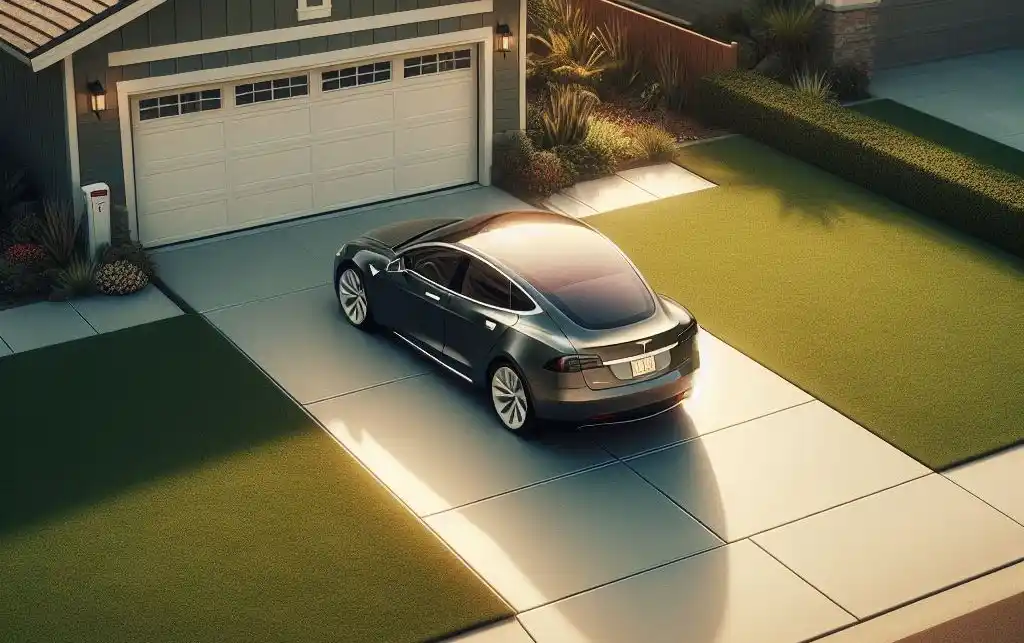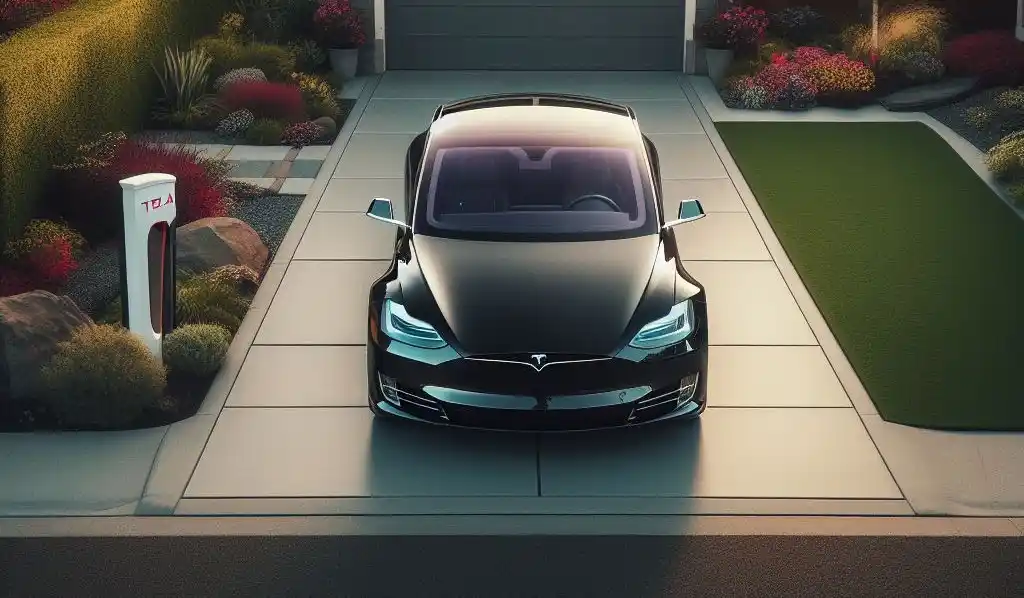How Many Solar Panels Do You Need for a Tesla Powerwall 2?
As a Tesla owner in the USA, you’re likely passionate about sustainability and reducing your reliance on traditional energy sources. Pairing your Tesla electric vehicle (EV) with a Tesla Powerwall 2 home battery system is a fantastic way to achieve this goal. But a crucial question arises: how many solar panels do you need to effectively charge your Powerwall 2 and power your Tesla?
This comprehensive guide dives deep into this topic, helping you determine How Many Solar Panels Do You Need for a Tesla Powerwall 2. We’ll explore key factors, analyze calculations, and provide valuable insights to make informed decisions for your solar and Tesla ecosystem.
Table of Contents
Understanding the Tesla Powerwall 2
The Tesla Powerwall 2 is a sleek, wall-mounted home battery that stores excess energy generated by your solar panels. This stored energy can then be used to power your home during peak electricity usage hours or blackout situations. It boasts a usable capacity of 13.5 kWh, offering significant backup power and the potential to offset your reliance on the grid.
Tesla Powerwall 2 Price
The Tesla Powerwall 2’s price falls within a range of $9,000 to $13,000 before taxes and installation. It’s crucial to remember this is just the starting point, and the final cost can be influenced by several factors:
- Location: Local permitting requirements and labor costs can affect the installation price.
- Number of Powerwall Units: If you desire a larger backup capacity, adding more Powerwall units will increase the overall cost.
- System Complexity: Factors like required wiring length and integration with your existing electrical system can impact installation complexity and cost.
Tesla Powerwall 3 Price
Unfortunately, at the time of writing (March 2, 2024), Tesla hasn’t officially released pricing information for the Tesla Powerwall 3. The Powerwall 3 is a relatively new product with details still emerging.
While waiting for the Powerwall 3 price, you can consider the Tesla Powerwall 2 as a reference point. The Powerwall 2 typically ranges from $9,000 to $13,000 before taxes and installation. The Powerwall 3 might be priced similarly or slightly higher due to its newer technology and integrated features.
Benefits of Pairing Powerwall 2 with Solar Panels:
- Reduced Electricity Bills: Offset grid dependence by utilizing self-generated solar power.
- Increased Self-Sufficiency: Enhance energy independence and resilience during power outages.
- Environmental Friendliness: Power your Tesla and home with clean, renewable energy.
- Potential Incentives: Take advantage of government rebates and tax credits for solar installations.
Key Factors Influencing Panel Requirements
Determining the ideal number of solar panels for your Powerwall 2 hinges on several critical factors:
- Your Daily Energy Consumption: Analyze your average daily household electricity usage (measured in kilowatt-hours or kWh) to understand your power needs. Utility bills or smart meter data can provide this information.
- Tesla Model and Charging Habits: Different Tesla models have varying battery capacities, impacting charging requirements. Consider how often you charge and your typical driving distance.
- Local Sun Exposure: The amount of sunlight your roof receives significantly affects solar panel output. Utilize online solar irradiance maps for your specific location to estimate daily peak sunlight hours.
- Solar Panel Efficiency: Higher efficiency panels generate more power per unit area, requiring fewer panels overall.
Calculating Your Solar Panel Needs: A Step-by-Step Guide

Here’s a breakdown of the steps involved in calculating the number of solar panels you’ll need:
- Estimate Daily Power Consumption:
- Gather your monthly electricity bills or smart meter data to determine your average daily kWh usage.
- Divide your monthly kWh consumption by the number of days in the billing cycle.
- Factor in Tesla Charging Needs:
- Research the battery capacity (kWh) of your specific Tesla model.
- Estimate your average daily or weekly charging frequency.
- Multiply your Tesla’s battery capacity by the number of charging cycles to determine the additional daily kWh required for charging.
- Consider Peak Usage and System Losses:
- Account for potential peak usage periods in your home during the day.
- Factor in a 10-15% buffer for system losses due to factors like inverter efficiency and wiring resistance.
Example Calculation:
Let’s assume:
- Daily home electricity usage: 15 kWh
- Tesla Model 3 with a 60 kWh battery
- Daily charging: Every other day
- Peak usage buffer: 15%
Step 1: Daily home usage = 15 kWh
Step 2: Daily Tesla charging = (60 kWh battery) / 2 (charging every other day) = 30 kWh
Step 3: Total daily power needs = 15 kWh (home) + 30 kWh (Tesla) = 45 kWh
Step 4: Account for peak usage and system losses: 45 kWh * 1.15 = 51.75 kWh
- Determine Required Solar Panel Wattage:
- Multiply your daily power needs (kWh) by your peak sunlight hours (obtained from solar irradiance maps) to determine the total Watt-hours (Wh) needed per day.
- Divide the daily Wh requirement by the chosen solar panel’s rated wattage (e.g., 300W) to calculate the total number of panels.
Example Calculation (Continued):
- Assuming 5 peak sunlight hours in your location:
- Daily Wh requirement = 51.75 kWh * 1000 Wh/kWh = 51,750 Wh
- Using 300W solar panels:
- Number of panels = 51,750 Wh / 300 W = 172.5 panels
Refining Your Panel Requirements and Additional Considerations

While the previous section provided a basic framework, it’s crucial to refine your panel requirements based on real-world factors:
- Seasonal Variations: Solar energy production fluctuates throughout the year. Consider installing additional panels to compensate for lower winter sunlight hours. A rule of thumb suggests adding 20-30% more panels to account for seasonal variations.
- Roof Size and Shading: Measure your usable roof space to ensure it can accommodate the calculated number of panels. Analyze potential shading from trees or nearby structures that can significantly impact panel output.
- System Design and Inverter Capacity: Consult with a qualified solar installer to design a system that optimizes panel placement, wiring, and inverter capacity. The inverter converts DC power from the panels to AC power for your home, and its capacity must be sufficient to handle the total panel output.
- Financial Considerations: The upfront cost of solar panels and installation can be significant. Explore financing options like solar loans or leases to make the system more accessible. Consider potential long-term savings on electricity bills and the potential for increased home value.
Here’s a table summarizing the key factors and calculations to keep in mind:
| Factor | Description |
|---|---|
| Daily Energy Consumption | Average daily household electricity usage (kWh) |
| Tesla Charging Needs | Battery capacity (kWh) x Charging frequency (days) |
| Peak Usage and System Losses | Buffer for increased demand and efficiency losses |
| Peak Sunlight Hours | Average daily sunlight hours in your location |
| Solar Panel Wattage | The rated power output of each panel (e.g., 300W) |
| Roof Size and Shading | Usable roof area and potential shading obstructions |
| Inverter Capacity | Ability to handle the total panel output |
| Financial Considerations | Upfront costs, financing options, and long-term savings |
Additional Considerations:
- Battery Backup Needs: If you prioritize extensive backup power during prolonged outages, consider installing additional Powerwall units.
- Future-Proofing: Factor in potential future increases in home energy consumption due to electric appliances or additional EVs.
- Aesthetics: Choose panel types and layouts that complement your home’s architectural style.
How long does it take to charge a Tesla Powerwall 2
The time it takes to charge a Tesla Powerwall 2 depends on two main factors:
- Power Input: This refers to the rate at which electricity is being supplied to the Powerwall 2 for charging.
- Current Charge Level: How depleted the Powerwall 2 is will influence how long it takes to reach a full charge.
Here’s a breakdown of charging times based on power input:
- Maximum Charge Rate: The Tesla Powerwall 2 boasts a maximum continuous charge rate of 5 kW. This means, under ideal conditions, a completely depleted Powerwall 2 can theoretically be charged in around 2.7 hours.
- Solar Panel Input: When relying solely on your solar panel system to charge the Powerwall 2, the charging time will vary depending on the total power output of your panels and the amount of sunlight available. In optimal conditions (peak sunlight hours), a properly sized solar panel system can potentially charge a Powerwall 2 in several hours. However, on cloudy days or during lower sunlight periods, the charging time will be significantly longer.
Additional Considerations:
- System Losses: Factor in a 10-15% buffer for system losses due to factors like inverter efficiency and wiring resistance. This may slightly extend the charging time.
- Partial Charges: If your goal isn’t a full charge, the charging time will be proportionately shorter.
In summary, the charging time for a Tesla Powerwall 2 can range from under 3 hours with a maximum power input to several hours when relying solely on solar panels. For the most accurate estimate, consider your specific solar panel system size and average daily sunlight exposure in your location.
How many solar panels to charge a Tesla Model Y

Unfortunately, there’s no one-size-fits-all answer to how many solar panels you need to charge a Tesla Model Y. The number depends on several critical factors that influence your daily energy needs:
1. Your Daily Household Electricity Consumption:
- Analyze your average daily electricity usage in kilowatt-hours (kWh) from your utility bills or smart meter data. This establishes your baseline power requirements.
2. Tesla Model Y Battery Capacity and Charging Habits:
- Research the battery capacity (kWh) of your specific Tesla Model Y variant (e.g., Long Range, Performance).
- Estimate your average daily or weekly charging frequency. How often you charge and the distance you typically drive significantly impacts the required daily kWh for charging.
3. Local Sun Exposure:
- The amount of sunlight your roof receives directly affects solar panel output. Utilize online solar irradiance maps for your location to determine the average peak sunlight hours per day.
4. Solar Panel Efficiency:
- Panels with higher efficiency ratings convert more sunlight into electricity, requiring fewer panels overall for the same power generation.
Here’s a step-by-step approach to estimate your required number of panels:
Step 1: Calculate Your Daily Power Needs:
- Daily home usage (kWh) + (Tesla Model Y battery capacity (kWh) / charging frequency (days))
Step 2: Account for Peak Usage and System Losses:
- Multiply the total daily power needs (kWh) by a 10-15% buffer to account for peak usage periods and system losses due to inverter efficiency and wiring resistance.
Step 3: Determine Required Solar Panel Wattage:
- Multiply the adjusted daily power needs (kWh) by your peak sunlight hours (obtained from solar irradiance maps) to determine the total Watt-hours (Wh) needed per day.
- Divide the daily Wh requirement by the chosen solar panel’s rated wattage (e.g., 300W) to calculate the total number of panels.
Example Calculation (assuming specific values):
- Daily home usage: 15 kWh
- Tesla Model Y Long Range (battery): 75 kWh
- Daily charging: Every other day
- Peak sunlight hours (location): 5 hours
- Solar panel efficiency: 20% (chosen for illustrative purposes)
- System buffer: 15%
Step 1: Daily power needs = 15 kWh (home) + (75 kWh / 2) = 45 kWh
Step 2: Adjusted daily power needs = 45 kWh * 1.15 = 51.75 kWh
Step 3: Assuming 300W solar panels:
- Daily Wh requirement = 51.75 kWh * 1000 Wh/kWh = 51,750 Wh
- Number of panels = 51,750 Wh / (300W * 0.20 efficiency) = 86.25 panels (round up to 87 panels)
Important Considerations:
- This is a simplified estimation. A qualified solar installer can provide a more accurate assessment based on your specific circumstances.
- Seasonal variations in sunlight hours may necessitate additional panels to compensate for lower winter generation.
- Roof size and potential shading from trees or structures can significantly impact panel output and may require adjustments to the estimated number.
Summary
By understanding your power needs, local sun exposure, and solar panel efficiency, you can determine the optimal number of panels for your Tesla Powerwall 2 system. Remember to factor in seasonal variations, roof limitations, and financial considerations for a comprehensive approach. Consulting with a qualified solar installer is crucial to design a system that meets your specific requirements and maximizes the benefits of powering your Tesla and home with clean, sustainable solar energy.
FAQs
Q: How much does it cost to install a solar panel system for a Tesla Powerwall 2?
A: The cost varies depending on factors like location, system size, chosen equipment, and installation complexity. Generally, expect a range of $10,000 to $20,000 or more. However, potential government incentives and long-term electricity bill savings can significantly impact the overall investment payback period.
Q: Can I install a solar panel system myself for my Powerwall 2?
A: While technically possible, DIY solar panel installations are not recommended for safety reasons. Improper installation can lead to electrical hazards, roof damage, and voiding of warranties. Consulting with a certified solar installer ensures a safe and efficient system that meets all local codes and regulations.
Q: What are the environmental benefits of using solar panels with a Tesla Powerwall 2?
A: Solar energy is a clean and renewable source of power, helping to reduce your reliance on fossil fuels and greenhouse gas emissions. Additionally, by powering your Tesla with solar energy, you contribute to a more sustainable transportation future.
Conclusion
Harnessing the power of the sun to charge your Tesla and power your home is a rewarding investment in sustainability and self-reliance. By carefully considering the factors outlined in this guide, you can make informed decisions about your Tesla Powerwall 2 and solar panel system. Remember, the ideal number of panels is unique to your situation. Consulting with a qualified solar installer in your area is the most effective way to determine the precise number of panels required to achieve your energy independence goals. They can assess your site specifics, analyze your energy usage patterns, and design a customized system that optimizes your Tesla charging experience and maximizes your home’s solar power potential.







